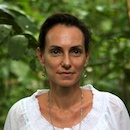4 Oct 2019 | 14:00 - 15:00 | R07 - Wing 2
Subplenary: Tropical wetlands, climate, and land-use change: Challenges and opportunities
The goal of this session is to generate a science-policy dialogue and provide credible scientific information for sound decision making related to the role of tropical wetlands in climate change adaptation and mitigation strategies. This session will encompass biophysical, socio-economic and governance facets of wetlands for effective conservation and restoration. This subplenary will focus on South American wetlands and include short presentations followed by a discussion panel.
Chair: Natalia Málaga

Kristell Hergoualc'h
Scientist, CIFOR
New research results on the extent and the nature of degradation of peatlands in northwestern South America
Tropical peatland maps have been developed using national data and from surveys undertaken by the International Peat Society. Much of the underlying primary data is untraceable and uncertainty information is often unavailable. Thus, a fresh approach was warranted. We used an expert system model to develop a new map of tropical and subtropical peatlands that shows that tropical and subtropical peatlands are more widespread in South America than on any other continent, with extensive areas in Brazil, Colombia, Peru and Venezuela. The massive scale, isolation and unavailability of most tropical South Latin American peatlands has protected them from large-scale human degradation, keeping them out of the interest of the international community, in contrast to the heavily disturbed Southeast Asian peatlands. New climatic stresses, such as increased droughts and fire frequencies could, undo their forgotten status. Our fieldwork looked at peatlands in 2 biomes: the Peruvian Amazon and the Colombian Savannas. In a 350,000 ha area in Ucayali and Maranon River basins we found that 73 percent were degraded. Much of the degradation was associated with unsustainable harvesting of the fruits of Mauritia flexuosa. This degradation is characterized by a loss of palm density and vegetation carbon stocks. In the Colombian Savannas, the existence of peat soils has not been reported previously. We report new estimates for the extent of peat soils in the “flooded” savannas and we extrapolate field measurements to estimate the carbon stock for the region. This exercise validates and refines the results of pan tropical peatland map.
